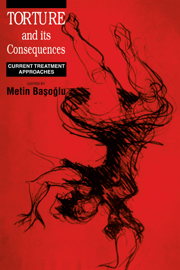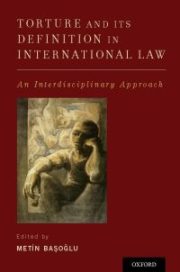Research news
Research suggests that brief and effective treatment of war and torture trauma is possible
Torture 2022
A recent study has shown that Control-Focused Behavioral Treatment, when administered in an average of 6 sessions in war and torture survivors, leads to high rates of recovery. The treatment achieved 82% reduction in posttraumatic stress symptoms in 60 survivors, leaving 97% of the cases nearly asymptomatic or with only mild symptoms. Meta-analytical comparisons suggest that such improvement rates are substantially higher than those achieved by other evidence-based treatments. ..Read Article
You can’t fight violence with violence
New Scientist July 2010
The past two decades have seen an increase in mass violence around the world, including wars, armed conflicts, human rights abuses and terrorism. Effectively dealing with these problems requires an understanding of the motivations that drive people to violence – sometimes to the point of self-sacrifice, as in the case of suicide bombers.
Unfortunately, attempts to develop such an understanding rarely go beyond value judgements, ideological beliefs and vacuous labels such as “fanatic” or “religious extremist”. What we need instead is a scientific analysis.
Acts of violence do not occur in a vacuum. The mass violence that characterizes the Israeli-Palestinian conflict, 9/11, the invasions of Afghanistan and Iraq, human rights abuses in Abu Ghraib and Guantánamo Bay and international terrorism can all be understood in terms of strong psychological motivators that inevitably create and sustain cycles of violence…Read New Scientist article.
Cruel, inhuman, and degrading treatment is more traumatic than physical torture
American Journal of Orthopsychiatry JUNE 2009
Current thinking on what constitutes torture in a detention / interrogation setting focuses solely on particular procedures, without regard for contextual factors that mediate traumatic stress. The present study examined stressor interactions that determined severity and psychological impact of captivity stressors in 432 torture survivors in former Yugoslavia countries and Turkey. A principal components analysis of 46 captivity stressors measured by an Exposure to Torture Scale identified meaningful stressor clusters, which suggested that multiple detention procedures were used in combination to maximize their impact. Perceived torture severity related to ‘cruel, inhuman, and degrading’ treatments (CIDT) but not to physical torture. Posttraumatic stress disorder related to war-related captivity, deprivation of basic needs, sexual torture, and exposure to extreme temperatures, isolation, and forced stress positions but not to physical torture. CIDT increased posttraumatic stress disorder risk by 71%. Fear- and helplessness-inducing effects of captivity and CIDT appear to be the major determinants of perceived severity of torture and psychological damage in detainees. Considerations on what constitutes torture need to take into account the contextual processes in a captivity setting that mediate these effects. Abstract
Earthquake survivors can be effectively treated using a self-help manual
Journal of Behavior Therapy and Experimental Psychiatry March 2009
Our previous studies showed that earthquake-related posttraumatic stress disorder could be reduced by a single session of therapist instructions for self-exposure to fear cues. In 8 single-case experimental studies we examined whether such instructions were as effective when delivered through a self-help manual after an initial assessment. After two baseline assessments conducted at the participants’ homes, the manual was delivered to the participants, who were then assessed at week 10 (post-treatment) and at 1-, 3-, and 6-month post-treatment. After minimal improvement during the baseline, treatment achieved marked improvement in seven survivors, leading to effect sizes comparable to those obtained by therapist-delivered treatment. Self-help appears to be a promising approach in cost-effective survivor care. The findings also suggest that, when the manual is delivered to survivors after minimal contact, more than 50% are likely to read it, follow the treatment instructions, and recover from PTSD and depression. This study represents a significant advance in the field, as it raises prospects of effective treatment of large numbers of earthquake survivors in the most cost-effective fashion, particularly when used as part of the Outreach Treatment Delivery Programme. Abstract
Study finds no distinction between torture and cruel, inhuman and degrading treatment
Archives of General Psychiatry March 2007
A study of 279 torture survivors in former Yugoslavia found no difference between physical torture and ‘non-physical’ stressors, including sexual advances, psychological manipulations, humiliating treatment, forced stress positions, sensory discomfort, and deprivation of basic needs in terms of their immediate and long-term psychological impact. Both types of stressors appeared to traumatize survivors by inducing helplessness. Study pointed to the need for a broader definition of torture by international conventions and the abolition of the distinction between torture and ‘cruel, inhuman and degrading treatment.’ The study was published with a commentary by Steve Miles, MD, from the Center for Bioethics, University of Minnesota. Full article
Earthquake Simulation Treatment found highly effective in reducing earthquake trauma
Psychological Medicine February 2007
A randomized controlled study showed that helping earthquake survivors to gain sense of control over tremors in an earthquake simulator reduces fear of earthquakes and leads to improvement in traumatic stress problems in 90% of the cases after a single session. The treatment was 20% more effective in reducing posttraumatic stress disorder than self-exposure instructions alone. Evidence also suggested that the intervention increases resilience against the traumatic effects of earthquakes. The study opens up prospects for psychologically preparing people for future earthquakes in earthquake-prone countries. Abstract
Debate on usefulness of torture rehabilitation programs
British Medical Journal December 2006
A recent British Medical Journal editorial by Metin Basoglu pointed to lack of evidence on the usefulness of current rehabilitation programs for refugees and torture survivors and the need for evidence-based approach in rehabilitation. The editorial prompted responses from various rehabilitation centers and health professionals, triggering a debate on various issues, including whether torture is different from other traumatic events and therefore more difficult to treat. The debate was published online by the journal.
A single treatment session leads to high rates of recovery from earthquake trauma
Journal of Traumatic Stress February 2005
A randomized controlled study showed that when earthquake survivors are encouraged not to avoid situations (e.g. entering concrete buildings) that evoke fear of earthquakes 80% comply and recover from traumatic stress. A single session designed to enhance survivors’ sense of control over fear was sufficient in initiating a self-help process in recovery from traumatic stress. Findings pointed to prospects of treating large survivor populations through mass media channels by simply providing encouragement for self-exposure to feared situations. Abstract





